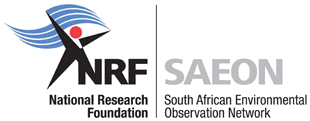South African Environmental Observation Network

SAEON
41 De Havilland Crescent,
The Woods,
Persequor Park,
PO Box 2600,
Pretoria 0001
South Africa
http://www.saeon.ac.za
Team:
SAEON
The Southern African environment is characterised by high levels of variability and biodiversity. Rainfall is a primary driver of the ecosystems, but its high variability limits its usefulness as an indicator of environmental change. Rainfall outcomes are complicated by the timing, frequency and intensity of rainfall events, as well as conditions of surface temperature, humidity, soil, slope and vegetation. These complexities, coupled with differential responses by thousands of species, cause uncertainty about the direction and extent of rainfall-induced change.
Southern Africa’s indigenous biodiversity, landscapes and oceans are continuously changed by diverse and adjoining land uses such as mining, farming, conservation, forestry, urban sprawl, communal resource management, fishing and golf estates. Time-series data covering the spectrum of spatial scales is essential for reliable data on significant environmental changes, some of which are slow, while others may be sudden. Data obtained over short periods and at single locations offers limited value.
The advance of climate change is already being observed but how and where it will impact on Southern African society remains uncertain. Rural communities, commonly desperate for resources and information, are particularly vulnerable to climatic variability, which is often aggravated by unsustainable agricultural and fishing practices, not only by those communities themselves, but also by commercial and illicit enterprises.
Earth observation science is thus urgently required to bring more certainty about environmental change, and to enable formulation of adaptive and mitigating management policies and practices, for themes ranging from food production to population health.
The South African Environmental Observation Network (SAEON) was established in 2002 after a process of deliberation within the research community.
Following extensive consultation with its sister departments, the Department of Science and Technology (DST) took the lead by mandating and funding the National Research Foundation to develop SAEON as an institutionalised network of departments, universities, science institutions and industrial partners.
According to the SAEON mandate, its responsibilities rest on three mandates: observation, information and education.
National Research Foundation (NRF)
The National Research Foundation (NRF) was established as an independent government agency, through the National Research Foundation Act (Act No 23 of 1998). The mandate of the NRF is to promote and support research through funding, human resource development and the provision of the necessary research facilities in order to facilitate the creation of knowledge, innovation and development in all fields of science and technology, including indigenous knowledge, and thereby contribute to the improvement of the quality of life of all South Africans.